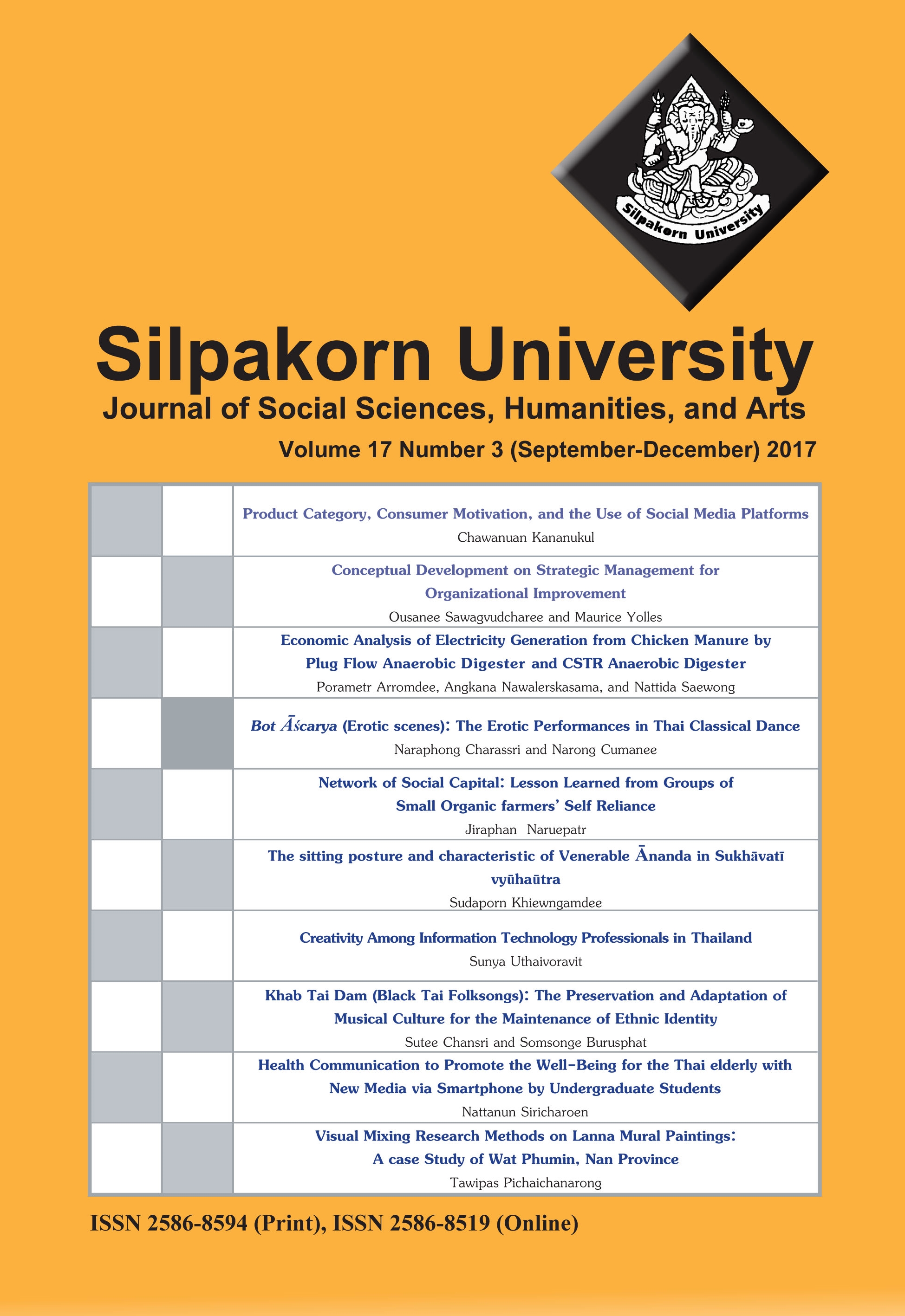Visual mixing research methods on Lanna mural paintings: A case study of Wat Phumin, Nan province
Main Article Content
Abstract
According to most of visitors who have visited Thai temples and have seen Thai mural paintings with untrained eyes, they might not understand a story on walls at first sight. It may be because Thai mural paintings look confusing, crowded with colorful figures that appears similar in detail and character, leaving no place to focus one’s attention (David K. Wyatt, 2004). Thai mural paintings is a disparate of the visual arts because of conventions that are entirely its own.This research is designed to study the capability of Thai and Foreign visitors in order to apprehend Lanna mural paintings through visual mixing research methods. For Methodology, questionnaires were used by collecting the data from the total of 411 Thai and foreign visitors who have been visited Wat Phumin, Nan province. At the same time, qualitative method was used by collecting the data form visitors who have been visited Wat Phumin, Nan province. The data then were analyzed using mean, descriptive statistics, and qualitative data. This study concludes that the comprehension of Lanna mural paintings at first sight from Thai and foreign visitors at Wat Phumin, Nan province are not positive. In addition, the results reported that our respondents have verified that there is no direction in order to understand stories on Lanna mural paintings from the beginning. Furthermore, the results reported that our respondents have established visual mixing research methods in order to discover more effective solutions to facilitate Thai and foreign visitors to obtain the information of the storytelling in Lanna mural paintings at first sight as possible
Downloads
Article Details
All rights reserved. Apart from citations for the purposes of research, private study, or criticism and review,no part of this publication may be reproduced, stored or transmitted in any other form without prior written permission by the publisher.
References
Boonjub, W. (2009). The Study of Thai Traditional Architecture as a Resource for Contemporary Building Design in Thailand. Bangkok: Graduate School, Silpakorn University.
Chen, C., & Tsai, D. (2007). How destination image and evaluative factors affect behavioral intentions?. Tourism Management, 28, 1115-1122.
Davis, R. (1984). Muang metaphysics. A Study on Northern Thai Myth and Ritual. Bangkok, Thailand: Pandora
De Bruijn, B. J. (1999). Foundations of Demographic Theory. Choice, process, context. Amsterdam: Thela Publishers.
Delcore, H. (2003). Non-Governmental Organizations (NGOs) and Development in Nan Province, Northern Thailand. American Ethnologist, 30(1), 61-84. doi:10.1525/ae.2003.30.1.61
Hennink, M. M., Hutter, I., & Bailey, A. (2011). Qualitative Research Methods. London: SAGE.
Hine, C. (2005). Virtual Methods: Issues in Social Research on the Internet. Oxford: Berg.
Hacker, T. (2009). Of Muscular Gods and Tattooed Men:Transformations in Thai Mural Painting. Singapore: Department of Southeast Asian studies, National University of Singapore.
Kaosa-ard, M. (2016). Development and Management of Tourism Products: The Thai Experience. Chiang Mai: Social Research Institute, Chiang Mai University.
Ongsavangchai, N. (2013). The Study of Architectural and Cultural Resources in Nan Municipality Area for Encouraging Community Based Tourism. International Critical Tourism Studies Conference V. Bosnia and Herzegovina, 358-373
Peterson, R. (1994). A Meta-Analysis of Cronbach’s Coefficient Alpha. Journal Of Consumer Research, 21(2), 381-391. Retrieved from https://www.jstor.org/stable/2489828
Rohrer, C. (2014). When to Use Which User-Experience Research Methods. Nngroup.com. Retrieved on August 8, 2016, from https://www.nngroup.com/articles/which-ux-research- methods/
Rogers, R. (2009). The End of the Virtual: Digital Methods. Amsterdam: Amsterdam University Press.
Rossi, A. (2012). Turning Red Rural Landscapes Yellow? Suffi ciency Economy and Royal Projects in the Hills of Nan Province, Northern Thailand. Austrian Journal of South-East Asian Studies, 5(2), 275-291.
Sommer, B. (2016). Scaling: Semantic differential. Psc.dss.ucdavis.edu. Retrieved on August 4, 2016, from https://psc.dss.ucdavis.edu/ sommerb/sommerdemo/scaling/semdiff.htm
Tashakkori, A., & Creswell, J. W. (2007). Editorial: The New Era of Mixed Methods. Journal of Mixed Methods Research, 1(1), 3-7.
Tavakol, M., & Dennick, R. (2011). Making sense of Cranach’s alpha. International Journal Of Medical Education, 2, 53-55
Vanichbuncha, K. (2002). The Statistical Analysis: Statistics. For Administration and Research (6th ed.). Bangkok: Chulalongkorn University Press.
Willekens, F. J. (1990). Beweging in de Demografie [Movement in demography].Inaugural lecture, Rijksuniversiteit Groningen (in Dutch).
Wissen, L., & Dykstra, P. (1999). Population issues. New York: Kluwer ademic/Plenum Publishers.
Wyatt, D. (2004). Reading Thai murals. Chiang Mai, Thailand: Silkworm Books


